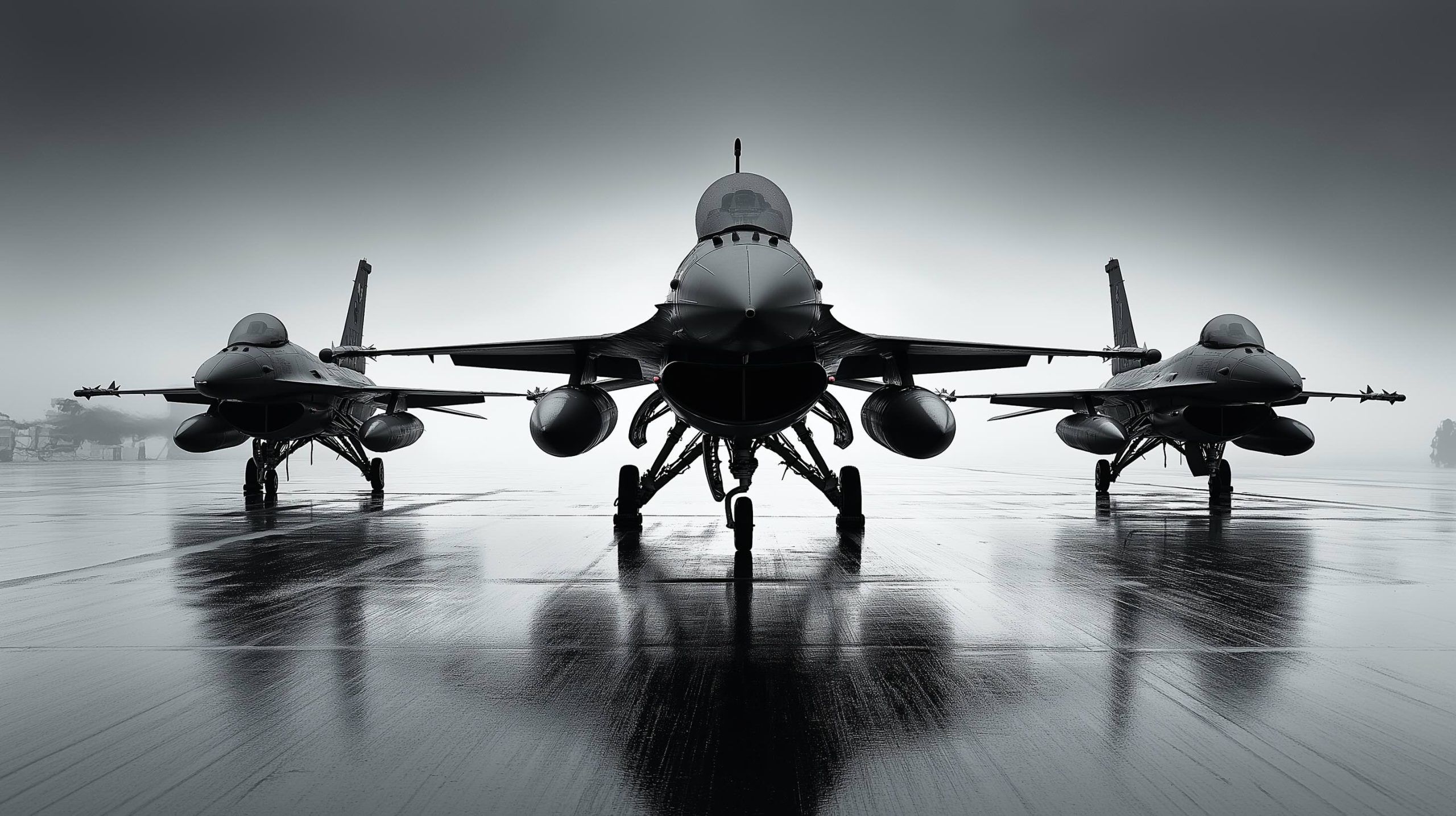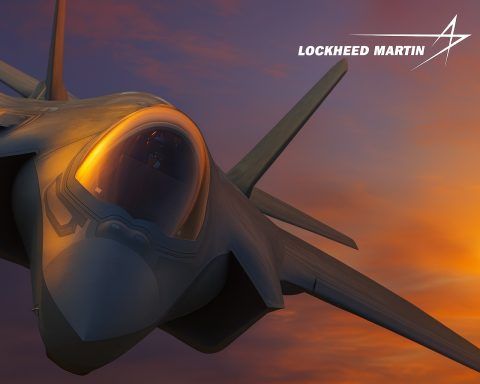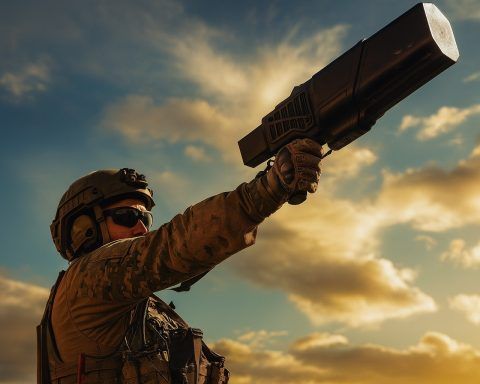- China publicly unveiled the Shenyang J-35 stealth fighter in 2025, with at least two J-35 prototypes seen at the SAC aircraft plant signaling low-rate production and a land-based J-35A variant.
- An upgraded J-15T naval fighter was revealed, featuring new indigenous engines, catapult launch capability for China’s carrier Fujian, an AESA radar, and compatibility with PL-10 and PL-15 missiles.
- The United States unveiled the F-47 NGAD in March 2025, Boeing winning the contract to build the world’s first crewed sixth-generation fighter, with a projected fleet of 220–250 NGADs and advanced AI copilots and modular design.
- Turkey’s TF-X Kaan completed its maiden flight in February 2024 and continued testing through 2025, attracting Saudi interest with talks of up to 100 Kaan jets and a timeline reportedly ahead of Western sixth-gen efforts by about a decade.
- Greece finalized a $3.8 billion deal to buy 20 F-35A Lightning II fighters, with deliveries expected to begin by 2028.
- In May 2025 India approved the Advanced Medium Combat Aircraft AMCA program, showcasing a full-scale model at Aero India 2025 and launching a domestic co-development partner invite for prototypes alongside the MMRCA 2.0 mega-tender.
- REFORPAC 2025 began in July from Misawa, Japan, comprising over 300 aircraft and thousands of personnel from the U.S., Japan, Australia and partners, marking the largest Pacific air exercise to date.
- Sweden’s Saab and Helsing conducted the first fighter jet test in May 2025 with an AI pilot agent controlling a Gripen E in realistic BVR combat as part of Project BEYOND, the AI trained on the equivalent of 30 years of simulated experience per week.
- In June 2025 China and Japan conducted a dual-carrier operation with Liaoning and Shandong in the Western Pacific for the first time, during which J-15 fighters intercepted a Japanese P-3C within 45 meters, prompting a formal protest from Tokyo.
- In May 2025 India and Pakistan fought an air conflict over Kashmir lasting several days, with a U.S.-brokered ceasefire and extensive drone use, marking the most serious clashes since 2019.
Newly Unveiled and Upgraded Fighter Jets in 2025 – Global Military Fighter Jet News Roundup from 2025
China publicly unveiled its new fifth-generation carrier jet program this year, revealing the Shenyang J-35 stealth fighter and an upgraded J-15T naval fighter [1] [2]. In a state media broadcast, at least two J-35 prototypes were seen at the SAC aircraft plant – the first public indication that China’s carrier stealth jet is entering low-rate production. Analysts note the J-35A (land-based variant) marks a leap in stealth, electronic warfare, and networking, designed to strike enemy aircraft and defenses with “one-way transparency” (ability to see first) against older jets [3] [4]. An upgraded J-15T (a 4.5-gen fighter derived from Su-33) was also revealed, featuring new indigenous engines, catapult launch capability for China’s new carrier Fujian, an AESA radar, and compatibility with PL-10/PL-15 missiles [5] [6]. With these moves, China becomes only the second nation (after the US) to field two different stealth fighters (the J-20 and new J-35) in service [7].
The United States made waves in March 2025 by officially unveiling its Next-Generation Air Dominance fighter, newly christened the F-47. In a White House ceremony, President Trump and USAF leaders announced that Boeing won the contract to build this world’s first crewed sixth-generation fighter [8] [9]. The F-47 NGAD is promised to outclass the F-22 Raptor in every aspect – featuring significantly longer range, “next-generation stealth” coatings, enhanced sensor fusion, and modular design for rapid upgrades [10] [11]. Artist’s renderings show a sleek tailless airframe with novel canard foreplanes and canted wings, a departure from current stealth designs [12]. Air Force Chief Gen. David Allvin touted it as America’s answer to rising threats, noting X-plane prototypes have flown “hundreds of hours” to mature F-47 technologies [13]. The F-47 program aims to field more airframes at lower cost than the F-22, with a projected fleet of 220–250 NGAD fighters in service [14] [15]. Experts say this sixth-gen jet will incorporate cutting-edge AI copilots, drone wingmen, and directed-energy weapons over its lifetime, ensuring the U.S. retains air dominance for decades [16] [17].
Other countries are not standing idle. Turkey’s “TF-X Kaan” fifth-generation fighter took its maiden flight in late February 2024 and continued developmental test flights through 2025 [18]. This Turkish stealth jet – one of the few 5th-gen projects outside the U.S. and China – is progressing rapidly, and Ankara is courting international partners to accelerate production. Notably, Saudi Arabia has shown keen interest in the Kaan program. In fact, after being rebuffed from joining the UK-Italy-Japan sixth-gen project (GCAP), Riyadh signaled it may acquire up to 100 Kaan fighters from Turkey [19] [20]. Analysts note the Kaan’s timeline is nearly a decade ahead of Western sixth-gen efforts, making it attractive for countries that seek advanced jets before 2040 [21] [22]. Meanwhile in Europe, development of next-gen fighters continues: the UK/Italy/Japan GCAP project formally established a joint venture company in late 2024, and France/Germany/Spain’s FCAS/SCAF program passed a key design milestone – though no physical prototypes have debuted yet. European industry did see a futuristic demo in 2025: Sweden’s Saab tested a Gripen E fighter controlled by an AI co-pilot (more on this below), hinting that crewed-uncrewed teaming will be central to Europe’s future jets [23] [24].
Major Fighter Deployments and Air Exercises
2025 has seen an upswing in large-scale air exercises and deployments across multiple regions, underscoring the heightened pace of global air power operations. In the Indo-Pacific, the U.S. and allies launched Resolute Force Pacific (REFORPAC) 2025 – the largest Pacific Air Force exercise ever [25]. Kicking off in July out of Misawa, Japan, REFORPAC involves over 300 aircraft and thousands of personnel from the U.S., Japan, Australia and other partners [26] [27]. The drills simulate high-tempo air combat in a contested environment, with distributed operations across Japan, Guam, Hawaii and open Pacific skies. “This exercise is about sharpening our edge and proving we can project combat airpower anytime, anywhere,” said Col. Paul Davidson of the USAF, as mixed squadrons of F-35s, F-15s, F-16s and Japanese F-2s practiced agile combat employment and contingency basing in austere conditions [28] [29]. The Pacific push comes as allies bolster readiness amid North Korean missile tests and an expanding Chinese air presence.
U.S. and allied F-35 Lightning II stealth fighters have been a centerpiece of large exercises like Talisman Sabre 2025, underscoring the growing role of 5th-generation jets. In Australia, July saw the largest-ever wargames on Australian soil with Exercise Talisman Sabre 2025. This biennial U.S.-Australia led drill swelled to 19 nations and 35,000 personnel – including forces from Japan, South Korea, India, Germany, France, Indonesia, and more [30] [31]. For the first time, parts of the exercise extended beyond Australia into nearby Papua New Guinea [32] [33]. Talisman Sabre featured extensive air combat training: Australian F-35A fighters and U.S. Marine Corps F-35Bs (operating off amphibious ships) flew alongside Japanese F-2s and Republic of Korea fighters in complex scenarios. A Royal Australian Air Force F-35A was even photographed screaming overhead during live-fire drills [34] [35]. The massive scale drew expected scrutiny from China – PLA Navy spy ships lingered off Australia to monitor the exercises, though officials said this “would be nothing unusual” and adjusted plans to mitigate any surveillance [36] [37].
Several high-profile multinational exercises reinforced cooperation in Europe and Asia. In June, Finland hosted Exercise Atlantic Trident 25, marking the first time this elite trilateral air combat drill (normally involving the US, UK, and France) was held outside those nations [38]. Freshly minted as a NATO member, Finland welcomed US F-35A and F-15E fighters, UK Typhoons, and French Rafales to train side-by-side with Finnish F/A-18 Hornets [39]. The exercise focused on Agile Combat Employment and cross-servicing – e.g. ground crews practicing refueling and rearming each other’s jets on austere airstrips [40] [41]. About 40 fighters and 1,000 personnel spread across Finland’s bases, even as a NATO RQ-4 Global Hawk drone deployed to Pirkkala Air Base for the first time to integrate long-range ISR into the drills [42] [43]. Farther south, the Philippines revived Exercise Cope Thunder after decades, underscoring the growing U.S.-Philippine defense ties. The July 2025 iteration of Cope Thunder saw the first deployment of U.S. F-35s to Philippine soil, joining Philippine Air Force FA-50PH light fighters in air combat exercises over Luzon [44] [45]. The Philippine Air Force committed some 2,300 airmen plus FA-50 jets and A-29 attack planes, while the U.S. PACAF sent 225 personnel and a contingent of F-35A Lightning II stealth fighters [46] [47]. Both sides conducted tactical training and subject-matter exchanges aimed at boosting interoperability, as the Philippines continues modernizing its air force amid regional tensions in the South China Sea [48].
Meanwhile, China’s air and naval forces undertook unprecedented deployments that raised regional alert levels. In June, Japan reported that two Chinese aircraft carriers – Liaoning and Shandong – were operating simultaneously in the Western Pacific for the first time [49] [50]. This dual-carrier deployment was accompanied by aggressive air maneuvers: Chinese carrier-based J-15 fighters repeatedly intercepted Japanese patrol aircraft in international airspace, flying within 45 meters of a Japanese P-3C and even cutting directly in front of it – a move Tokyo called “abnormally dangerous” [51] [52]. Japan lodged a formal protest over these unsafe intercepts, warning that such close approaches risk a mid-air collision [53] [54]. China’s defense ministry insisted Japanese surveillance caused the encounter, but U.S. and Japanese commanders see it as another sign of Beijing’s growing assertiveness beyond the First Island Chain [55] [56]. The incident, coming on the heels of Chinese jets harassing U.S. and allied aircraft over the South China Sea earlier in the year, highlights the high-stakes cat-and-mouse games unfolding in Asian skies in 2025.
Global Fighter Procurement Deals and Tenders
2025 has been marked by major fighter aircraft procurement moves around the world, as many nations ink new deals or launch tenders to modernize their air fleets:
- Europe and NATO: Greece finalized a landmark deal to purchase 20 F-35A Lightning II fighters from the U.S., making Greece the 19th country to join the F-35 program [57] [58]. Valued around $3.8 billion, the agreement was signed in late 2024 and affirmed in 2025 as part of Athens’ military overhaul, replacing aging F-4 Phantoms and Mirage 2000s. Deliveries of the Greek F-35s are expected to begin by 2028 [59]. This comes amid continued tensions with neighboring Turkey – itself expelled from the F-35 program – and Greek officials pointedly noted the fifth-gen jets will ensure air superiority over any regional adversary [60]. Also in NATO, Poland accelerated its fighter modernization: having received the first batch of 12 FA-50 light fighters from South Korea in 2023, Warsaw anticipated the delivery of improved FA-50PL variants by 2025. However, reports emerged of delays in the FA-50PL program, with manufacturing of the Polish-customized version slipping and likely pushing initial deliveries to 2026–27 [61] [62]. Poland is also on track to receive its first F-35s in the coming years, further bolstering NATO’s eastern flank airpower. And in a notable development, Finland and Denmark – both recent F-35 customers – announced plans in 2025 to donate retired F-16s to Ukraine once Ukrainian pilots are trained [63] [64]. (By mid-2025, Ukrainian personnel were undergoing accelerated F-16 training in Europe, and at least one donor nation, the Netherlands, reportedly transferred a handful of airframes for familiarization [65].)
- Middle East: Facing hurdles in buying Western fifth-gen jets, regional powers pursued alternate paths. Iran made headlines in early 2025 when a senior IRGC commander confirmed Tehran has purchased Russian Su-35 Flanker-E fighters [66] [67]. This was the first official acknowledgment of the long-rumored deal, though Iran did not specify how many jets or if deliveries had begun. (Analysts believe Iran hoped to acquire up to 24 Su-35s that Russia originally built for Egypt.) However, by spring 2025 there were twists – reports indicated that the Su-35s intended for Iran were instead diverted to Algeria, which had quietly become the first African customer for the Su-35 [68] [69]. Commercial satellite imagery in March showed Su-35 fighters with Algerian roundels arriving at an Algerian air base [70] [71]. Moreover, Algeria’s state media claimed it will soon receive a limited number of Russia’s next-gen Su-57 Felon stealth fighters, making it the first export client for the Su-57 as well [72] [73]. Denied those Russian jets, Iran pivoted to China – with insiders saying Tehran is now in talks to buy Chinese J-10C Vigorous Dragon fighters to update its aging fleet [74] [75]. Meanwhile the United Arab Emirates’ bid to acquire F-35s remained in limbo. The UAE had paused negotiations in 2021 over U.S. restrictions, and despite earlier hints it might revive the deal under a Trump administration, by 2025 Emirati officials reiterated they do not plan to resume F-35 talks given the unchanged U.S. tech transfer conditions [76] [77]. Instead, the UAE and other Gulf states are exploring European or indigenous options (like the UAE’s own stealth drone programs) as they diversify their fighter procurement.
- Asia-Pacific: Several countries moved forward on long-pending fighter tenders. In South Asia, India gave the green light to its ambitious indigenous stealth fighter project. In May 2025, India’s defense minister approved a framework to build the Advanced Medium Combat Aircraft (AMCA), a twin-engine stealth jet envisioned as a 5th-gen (or “5.5-gen”) platform to rival China’s J-20 [78] [79]. A full-scale AMCA model stole the show at Aero India 2025, and by June the Indian Air Force’s development agency issued invites for domestic industry partners to co-develop the prototype [80]. This program is critical for India, which has seen its fighter squadron strength drop to 31 (from a desired 42) as old MiGs retire [81]. New Delhi also floated a mega-tender for 114 multi-role fighters (MMRCA 2.0), with Western and Russian jets all vying, though no winner has been chosen yet. In East Asia, Japan and its GCAP partners (UK and Italy) formally established a joint entity in late 2024 to design a sixth-gen fighter by 2035 [82] [83]. Japan’s reluctance to include Saudi Arabia as a partner (due to security concerns) solidified the original trio. South Korea, for its part, continued testing its KF-21 Boramae fighter, with several prototypes flying since 2022. By 2025 the KF-21 achieved supersonic flight and began weapons trials, keeping it on track for production later in the decade. And Indonesia made news in Southeast Asia by decisively picking new fighter jets: In July 2025, Peru (in South America) actually provided a preview – the Peruvian Air Force selected Sweden’s Saab Gripen E/F over the Rafale and F-16 in a $3.5B deal for 24 jets [84] [85]. Inspired by regional trends (Brazil, Colombia, etc.), Colombia also announced its intent to buy Saab Gripen fighters to replace its retiring Kfirs, turning down offers of F-16s and Rafales [86] [87]. These moves highlight a growing acceptance of the Gripen in Latin America. Closer to home, Indonesia and Malaysia have been evaluating the Gripen too, though Indonesia earlier signed contracts for French Rafales and expressed interest in American F-15IDs.
- Americas: Outside of U.S. programs, Latin American nations emerged on the fighter procurement scene for the first time in decades. As noted, Peru’s decision to acquire 24 Gripen Es in 2025 is a major leap, replacing its 1970s-era Mirages and MiG-29s [88] [89]. The deal includes tech transfer and an offer to deliver the first jets by 2026 to coincide with Peru’s Air Force anniversary [90]. Colombia, after extensive evaluations, also chose the Gripen E/F, with President Gustavo Petro confirming the selection of an estimated 16–24 jets pending final contract talks [91] [92]. Saab’s CEO expressed high confidence since Colombia “publicly said they have chosen us” [93]. These developments, along with Argentina’s ongoing interest in new fighters, suggest a shifting dynamic where smaller air forces seek affordable 4.5-gen jets with favorable financing and industrial benefits – a niche the Gripen is exploiting [94] [95].
Breakthroughs in Stealth, Weapons, and AI Technologies
Several technological breakthroughs and trials in 2025 are pushing the envelope of fighter capabilities – from stealth enhancements to artificial intelligence in air combat:
- Stealth and Counter-Stealth: With more stealth fighters coming online (F-35, J-20, Su-57, etc.), researchers are racing to improve detection and counter-stealth. In 2025, European and U.S. firms unveiled upgrades to fighter radars – for example, Eurofighter Typhoons began receiving new ECRS Mk2 AESA radars with improved ability to detect low-observable targets at longer ranges (allowing better tracking of stealthy aircraft). Lockheed Martin tested a prototype IRST (Infrared Search & Track) system on an F-15EX, demonstrating passive detection of stealth cruise missiles beyond visual range. Meanwhile, the new Chinese J-15T naval fighter’s radar reportedly has improved target discrimination and can network with other PLA Navy assets to counter stealth threats [96]. Stealth coatings themselves saw advances: France’s Dassault revealed that the upcoming Rafale F5 standard will incorporate some radar-absorbing material improvements derived from its nEUROn UAV program, potentially reducing the Rafale’s front-aspect RCS. And the U.S. Air Force confirmed it is experimenting with “Digital Camouflage” for stealth aircraft – dynamic surface panels that can alter electromagnetic signature in real time, a concept that might feature on the NGAD F-47.
- Weapons Integration and Hypersonics: A big focus in 2025 is integrating new weaponry onto fighters. The U.S. Navy completed integrating the long-range AGM-158C LRASM anti-ship missile on its F/A-18E/F Super Hornets, giving carrier fighters a potent standoff punch against warships [97]. The F-35A is also testing a novel 1,000km-range glide bomb as part of the USAF’s Rapid Dragon program (originally for palletized munitions), expanding the Lightning II’s strike reach. In Russia, Sukhoi announced a modified Su-34 strike fighter successfully launched a prototype hypersonic air-launched missile during a test – a likely derivative of the Kh-47M2 Kinzhal – though Western analysts remain skeptical of its accuracy. European partner nations confirmed that the upcoming Meteor beyond-visual-range missile has been integrated onto additional platforms: Spain test-fired a Meteor from an EF-18 Hornet using an experimental datalink pod, and India’s trials to arm its Su-30MKI with the Meteor (via a new AESA radar) are ongoing after acquiring Meteor stocks for its Rafales. These integrations ensure even 4th-gen fighters can carry some of the latest smart weapons.
- Artificial Intelligence in Fighter Combat: Perhaps the most game-changing development is the leap toward AI-assisted and autonomous fighter operations. In late May 2025, Sweden’s Saab, with German startup Helsing, conducted the first-ever test of a fighter jet controlled in part by an AI pilot agent in real aerial combat scenarios [98] [99]. Codenamed Project BEYOND, the trials saw a Gripen E fly multiple sorties with Helsing’s “Centaur” AI system in the backseat, including one flight where an AI-piloted Gripen engaged in a beyond-visual-range duel against a human-piloted Gripen D [100] [101]. This is the first known instance of an AI controlling a frontline fighter in realistic BVR combat – previously, AI dogfights were confined to simulators or subscale drones. The results were inconclusive on whether the AI or human “Top Gun” prevailed, but notably the AI had been trained on the equivalent of 30 years of simulated fighter experience per week [102] [103]. Saab’s test pilot, also a former fighter ace, said “it’s not a given who will win…you have to be on your game as a pilot,” acknowledging that while today a veteran human can still compete, that balance may tip quickly as AI algorithms learn and improve [104] [105]. This milestone follows a 2024 DARPA experiment where an AI agent flew a U.S. Air Force X-62 VISTA F-16 in close dogfights. Both efforts underscore how 6th-generation programs (NGAD, GCAP, etc.) are expected to leverage AI for tactics, faster decision loops, and even autonomous wingmen drones. Indeed, former USAF Secretary Frank Kendall remarked that AI decision-making will “routinely overpower humans” in air combat – though all Western projects insist a human will remain in the loop for lethal force decisions [106] [107].
- Other Innovations: Fifth-gen and legacy fighters alike saw tech upgrades. The U.S. Air Force began fielding a new Autonomous Ground Collision Avoidance System (Auto-GCAS) update for its F-35 fleet, credited with saving several pilot lives in F-16s. Israel revealed an AI-enhanced mission planning system, “Fire Weaver,” which was used operationally to rapidly pair fighter sorties (F-35I Adir strikes) with ground-based targets in the 2024 Gaza conflict – a sign of AI aiding command and control. And Russia claimed it has tested a form of quantum radar for anti-stealth detection, installing a prototype radar on a MiG-31 interceptor; Western analysts, however, are skeptical of those claims absent verifiable data. In terms of materials, Japan’s ATLA research agency announced progress on a new heat-resistant composite skin for stealth aircraft, aiming to enable fighters to super-cruise at Mach 2 for extended periods without damage – a feature likely intended for the GCAP sixth-gen jet.
Expert Analysis and Commentary
Military experts are noting that 2025’s fighter jet developments collectively point to shifting balances and new doctrines in air warfare. Gabriel Honrada, writing for Asia Times, observed that China’s simultaneous carrier fighter advances – the stealthy J-35 and upgraded J-15T – reflect Beijing’s intent to “redefine naval power in the Indo-Pacific”, even as limitations (like lack of carrier experience and fewer auxiliaries) tether its global reach [108] [109]. Western analysts compare China’s two stealth fighters to America’s F-22/F-35 duo, suggesting the PLA is closing the capability gap faster than anticipated [110]. However, experts also point out persistent hurdles for China: Jonathan Caverley notes that China’s carriers still lack the range and combat endurance of U.S. nuclear carriers, and without a robust carrier-based AEW aircraft and tanker fleet, Chinese carrier groups in 2025 remain largely regional forces rather than global game-changers [111] [112].
In the Middle East, Michele Groppi at the Atlantic Council explains Saudi Arabia’s fervent interest in next-gen fighters as part of Riyadh’s strategy to reduce reliance on U.S. arms and gain domestic production capability. After the U.S. blocked Saudi access to the F-35 (favoring Israel’s qualitative edge), the Kingdom’s attempted entry into the GCAP project was stymied by Japan [113] [114]. This led Saudi decision-makers to look at Turkey’s Kaan fighter – which, unlike the still-conceptual GCAP jet, has already flown and could enter service by late this decade. Analysts note the timing: the Kaan is “at least ten years ahead” of GCAP’s timeline, and Turkey is open to co-production and technology transfer in ways the U.S. or Japan are not [115] [116]. If Saudi Arabia indeed invests in 100 Kaan jets, experts say it would be “a significant shift in the defense landscape”, bolstering Saudi-Turkish ties and injecting major funding into Turkey’s program (potentially accelerating it and lowering per-unit costs) [117] [118]. On the flip side, Israeli defense commentators worry that an advanced Saudi fleet – whether via Turkey or eventually GCAP – could upset the region’s long-term airpower balance, especially as Egypt also acquires modern Rafales and possibly Su-35s.
In Europe and NATO, defense analysts highlight how the proliferation of F-35s among allied air forces is creating a more unified air combat framework. As Breaking Defense reported, Greece’s addition of the F-35 means nearly all Mediterranean NATO states will operate the jet, enhancing interoperability for coalition operations [119] [120]. Lockheed Martin officials have called the F-35’s spread “a powerful testament of alliance-based deterrence”, since the jet’s ability to securely share targeting data can link disparate national fleets into one network [121]. Yet experts also caution that reliance on a single platform has risks: common cybersecurity vulnerabilities or fleet-wide grounding issues (like an engine fault) could affect many nations at once. Therefore, European strategists see the development of two parallel sixth-gen fighters (GCAP and FCAS) as insurance that Europe isn’t dependent on one type of U.S. fighter in the 2030s and beyond.
Finally, on the technology front, the AI-vs-pilot dogfight trials sparked debate among fighter tacticians. Marcus Wandt, Saab’s chief test pilot for the AI project (and a former astronaut), noted that AI agents can practice millions of scenarios in simulation, evolving new tactics that humans might not expect [122] [123]. He recounted that the AI “Centaur” sometimes made unconventional beyond-visual-range engagement decisions that a human pilot found hard to anticipate – highlighting the potential for AI to augment pilot decision-making or even take the lead in certain high-speed OODA loops. U.S. Air Force leaders similarly commented that the goal is not to replace human pilots, but to offload repetitive tasks and allow AI to propose tactics rapidly, with the human retaining override authority [124]. As one Air Force colonel quipped, the mix of man and machine in the cockpit could become like a chess team of a grandmaster paired with a computer – “the centaur model” – which consistently beats either alone.
Notable Incidents and Aerial Conflicts in 2025
Beyond exercises and demos, 2025 has unfortunately seen real-world conflicts and incidents involving fighter aircraft:
- In May 2025, India and Pakistan engaged in a brief but intense air conflict that lasted several days – the most serious aerial clashes between the nuclear-armed neighbors since the Balakot crisis of 2019. The fighting erupted along the Line of Control in Kashmir and escalated into air strikes and skirmishes, with both sides deploying fighter jets, armed drones, and missiles before a U.S.-brokered ceasefire was announced [125] [126]. Notably, India employed its new Rafale fighters and legacy Mirage 2000s for precision strikes on claimed militant targets, while Pakistan scrambled its U.S.-supplied F-16s and Chinese-made JF-17s. It was the first conflict where both India and Pakistan used armed drones extensively, along with fighters – a development that led New Delhi to accelerate its own drone programs after seeing swarms in action [127] [128]. The clashes underscored an arms race in the subcontinent: India’s approval of the AMCA stealth fighter project came “amid a new arms race with Pakistan”, who has begun fielding Chinese J-10C fighters that were spotted during the confrontation [129] [130]. Regional security analysts warn that without sustained dialogue, both air forces are on hair-trigger alert, and a future incident could spiral even faster given the advanced fighters now in play.
- In Ukraine, the air war between Russia’s Air Force and Ukrainian air defenses ground on into 2025 with incremental developments. While Russia has largely kept its modern fighters like Su-35s and MiG-31s out of Ukrainian SAM range, one notable incident occurred in June 2025: Ukraine claimed to shoot down a Russian Su-35S near the front lines in the Kursk region [131]. Video footage showed the wreckage of a Su-35 burning, and Ukrainian officials said a mobile air defense unit likely scored the hit [132]. This is significant because the Su-35 is Russia’s top operational air-superiority fighter, and losses have been rare. The Su-35’s downing – possibly by a Buk-M1 or Western-supplied system – demonstrates that even advanced fighters are vulnerable if they stray within range of modern SAMs. In response, Russia further pulled back high-value jets, relying more on standoff weapons like glide bombs and cruise missiles. Meanwhile, Ukrainian pilots await Western fighters: by mid-2025, Ukraine had reportedly received a few refurbished MiG-29s and perhaps the first donated F-16s for training, but they have not yet been seen in combat [133]. The first full squadron of Ukrainian F-16s – drawn from Dutch, Norwegian, and Danish pledges – is expected to become operational in 2026, so for now Ukraine’s air force concentrates on survivability and occasional low-level Su-25 and MiG-29 sorties. The skies over Ukraine remain contested, with neither side able to achieve air superiority: Russian fighters often fire long-range missiles from within Russian airspace, while Ukrainian crews use terrain masking to launch sporadic attacks. The 2025 trend is a kind of aerial stalemate, broken by periodic drone and missile strikes but few dogfights.
- In the Middle East, Israeli fighter jets saw significant action in late 2024 and early 2025 during the Israel–Hamas war and subsequent regional flare-ups. Israel’s F-35I “Adir” stealth fighters flew numerous strike missions against targets in Gaza, often at night and in GPS-denied environments. The IDF credited the F-35’s sensors and precision for reducing collateral damage, and there were unconfirmed reports that an Israeli F-35I conducted a first-of-its-kind airstrike using a Rafael Spice 2000 glide bomb guided entirely by an onboard AI target recognition system. Separately, tensions with Hezbollah in early 2025 led to Israeli Air Force air strikes in southern Lebanon, where F-16I Sufa jets dodged several SA-22/Pantsir SAM shots (some sources say one F-16 took minor shrapnel damage but landed safely). Also noteworthy: In April 2025, two U.S. Air Force F-15E Strike Eagles were scrambled from the Gulf to intercept Iranian Su-22 jets that appeared to be approaching an American drone in Syrian airspace – the Su-22s backed off after the F-15Es arrived, averting a confrontation. It’s a reminder that even as great-power fighters grab headlines, older 3rd- and 4th-generation jets are still actively involved in various conflicts and flashpoints around the world.
Sources: The information above is compiled from a wide range of 2025 defense news reports and expert analyses, including official military press releases, reputable news agencies, and defense think-tank publications. Key references include Reuters [134] [135], Air Force Magazine [136], Asia Times [137] [138], Breaking Defense [139], the Atlantic Council [140], and others as cited throughout the text. These sources provide first-hand details on fighter unveilings, military exercises, contract deals, technology trials, and conflict incidents in 2025, offering a comprehensive global overview of the fast-evolving fighter jet landscape.
References
1. asiatimes.com, 2. asiatimes.com, 3. asiatimes.com, 4. asiatimes.com, 5. asiatimes.com, 6. asiatimes.com, 7. asiatimes.com, 8. www.airandspaceforces.com, 9. www.af.mil, 10. www.airandspaceforces.com, 11. www.af.mil, 12. www.airandspaceforces.com, 13. www.airandspaceforces.com, 14. www.airandspaceforces.com, 15. www.airandspaceforces.com, 16. www.reuters.com, 17. www.reuters.com, 18. turdef.com, 19. www.atlanticcouncil.org, 20. www.atlanticcouncil.org, 21. www.atlanticcouncil.org, 22. www.atlanticcouncil.org, 23. www.reuters.com, 24. www.reuters.com, 25. www.af.mil, 26. www.af.mil, 27. www.af.mil, 28. www.af.mil, 29. www.af.mil, 30. www.kpbs.org, 31. www.kpbs.org, 32. www.kpbs.org, 33. www.kpbs.org, 34. www.kpbs.org, 35. www.kpbs.org, 36. www.kpbs.org, 37. www.kpbs.org, 38. ilmavoimat.fi, 39. ilmavoimat.fi, 40. ilmavoimat.fi, 41. ilmavoimat.fi, 42. ilmavoimat.fi, 43. ilmavoimat.fi, 44. www.gmanetwork.com, 45. www.gmanetwork.com, 46. www.gmanetwork.com, 47. www.gmanetwork.com, 48. www.gmanetwork.com, 49. www.reuters.com, 50. www.reuters.com, 51. www.reuters.com, 52. www.reuters.com, 53. www.reuters.com, 54. www.reuters.com, 55. www.reuters.com, 56. www.reuters.com, 57. breakingdefense.com, 58. breakingdefense.com, 59. breakingdefense.com, 60. breakingdefense.com, 61. www.aviacionline.com, 62. www.defensemagazine.com, 63. www.newsweek.com, 64. kyivindependent.com, 65. www.aerotime.aero, 66. www.reuters.com, 67. www.reuters.com, 68. www.twz.com, 69. www.twz.com, 70. www.twz.com, 71. www.twz.com, 72. www.twz.com, 73. www.twz.com, 74. www.aeronewsjournal.com, 75. www.facebook.com, 76. www.reuters.com, 77. www.reuters.com, 78. www.reuters.com, 79. www.reuters.com, 80. www.reuters.com, 81. www.reuters.com, 82. www.atlanticcouncil.org, 83. www.atlanticcouncil.org, 84. www.aeronewsjournal.com, 85. www.aeronewsjournal.com, 86. www.reuters.com, 87. www.reuters.com, 88. armyrecognition.com, 89. armyrecognition.com, 90. www.aeronewsjournal.com, 91. www.reuters.com, 92. www.reuters.com, 93. www.reuters.com, 94. www.aeronewsjournal.com, 95. www.aeronewsjournal.com, 96. asiatimes.com, 97. asiatimes.com, 98. www.reuters.com, 99. www.reuters.com, 100. www.reuters.com, 101. www.reuters.com, 102. www.reuters.com, 103. www.reuters.com, 104. www.reuters.com, 105. www.reuters.com, 106. www.reuters.com, 107. www.reuters.com, 108. asiatimes.com, 109. asiatimes.com, 110. asiatimes.com, 111. asiatimes.com, 112. asiatimes.com, 113. www.atlanticcouncil.org, 114. www.atlanticcouncil.org, 115. www.atlanticcouncil.org, 116. www.atlanticcouncil.org, 117. www.atlanticcouncil.org, 118. www.atlanticcouncil.org, 119. breakingdefense.com, 120. breakingdefense.com, 121. breakingdefense.com, 122. www.reuters.com, 123. www.reuters.com, 124. www.reuters.com, 125. www.reuters.com, 126. www.reuters.com, 127. www.reuters.com, 128. www.reuters.com, 129. www.reuters.com, 130. www.reuters.com, 131. en.wikipedia.org, 132. en.wikipedia.org, 133. www.aerotime.aero, 134. www.reuters.com, 135. www.reuters.com, 136. www.airandspaceforces.com, 137. asiatimes.com, 138. asiatimes.com, 139. breakingdefense.com, 140. www.atlanticcouncil.org









![BIO-key (BKYI) spikes on major Middle East defense biometric deployment — stock reacts as company expands EMEA footprint [Nov. 7, 2025] BIO-key (BKYI) spikes on major Middle East defense biometric deployment — stock reacts as company expands EMEA footprint [Nov. 7, 2025]](https://ts2.tech/wp-content/uploads/2025/11/BIO-key-International-480x384.jpg)
